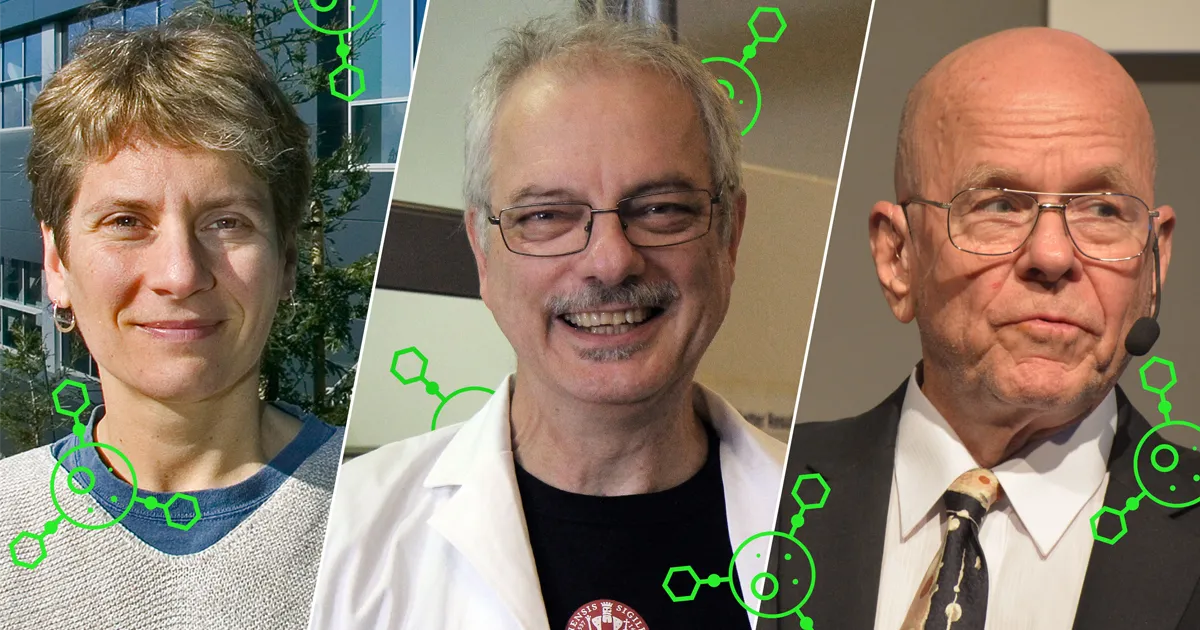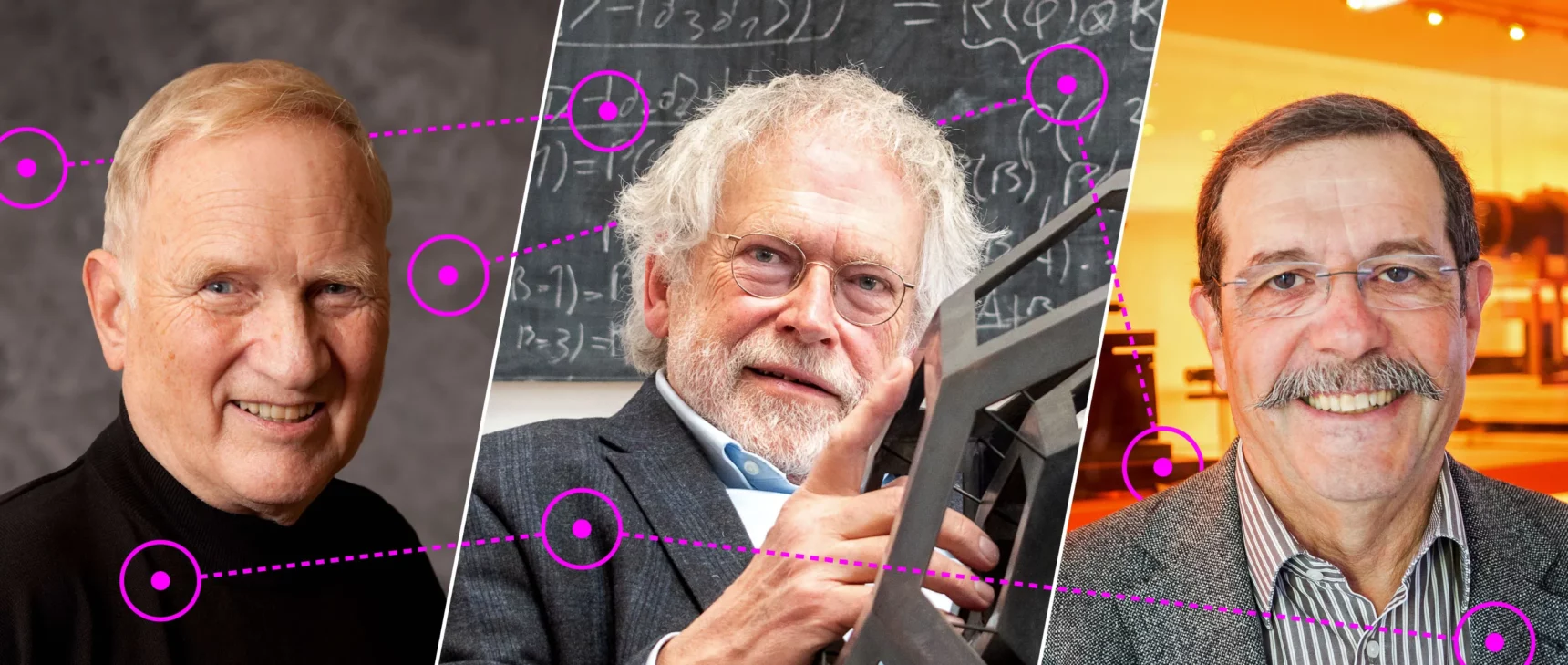Molecule-Building Innovators Win Nobel Prize in Chemistry

The 2022 Nobel Prize for Chemistry has been jointly awarded to three researchers: Carolyn Bertozzi, for her development of bioorthogonal chemistry, and Morten Meldal and K. Barry Sharpless, for their independent development of click chemistry.
(left): Roy Kaltschmidt, LBNL; Jens Christian Navarro Poulsen, University of Copenhagen; Bengt Oberger
Introduction
Carolyn Bertozzi, Morten Meldal and K. Barry Sharpless have been awarded the 2022 Nobel Prize in Chemistry for the development of click chemistry and bioorthogonal chemistry. Click chemistry revolutionized the options available to chemists for creating the molecules they desired. Bioorthogonal chemistry made it possible to monitor the chemical processes going on inside living cells without harming them.
“It’s all about snapping molecules together,” said Johan Åqvist, chair of the Nobel Committee for Chemistry, during the announcement. Imagine, he told the audience, that you could attach small chemical buckles to a bunch of different types of molecular building blocks and then link these buckles together to produce complex molecules. That idea, put forth by Barry Sharpless of the Scripps Research Institute about 20 years ago, later became reality when he and Morten Meldal of the University of Copenhagen independently found the first perfect candidates for the job. Their buckles easily snapped together and wouldn’t link onto anything they shouldn’t.
Then, in 2003, Carolyn Bertozzi proposed that click chemistry could be used in studies of biological systems to make it easier to observe vital cellular processes without interfering with them. Bertozzi called this “bioorthogonal” chemistry in a paper she and her colleagues published that year. The term has since been widely-adopted term in the field.
The ability to perform complex reactions in living systems without interfering with natural biological reactions made it possible to study molecules and cellular processes in cells and inside complex organisms such as zebra fish, rather than in laboratory dishes. It has already helped scientists understand an important protein processing reaction called glycosylation, helped to develop molecular imaging molecules that could detect disease in living organisms, and opened up the possibility of selectively delivering drugs to particular tissues in the body.
These findings have “led to a revolution in how chemists think about linking molecules together and how to do it in living cells,” Åqvist said.
Today’s announcement marks the second time that Sharpless has won a Nobel Prize in Chemistry. In 2001, he shared the prize with William Knowles and Ryoji Noyori for the development of catalytic asymmetric synthesis.
What is click chemistry?
Sharpless spent much of the 1990s considering the need to find less cumbersome ways to synthesize complex molecules. His thinking culminated in a 2001 paper in which he and his co-authors proposed the term “click chemistry” to refer to any reaction that links together molecular building blocks in an efficient, specific and quick manner. Shortly after the publication of the paper, Meldal and Sharpless independently discovered the first click chemistry reaction: a highly useful one called the copper-catalyzed azide-alkyne cycloaddition.
Merrill Sherman/Quanta Magazine
On one side of the reaction is an azide, a molecule that has three nitrogen atoms in a row. On the other side is an alkyne, a molecule in which two carbon atoms are bonded together with a triplet bond. By themselves, these two building blocks aren’t very reactive: Mixed together, they are slow to react and yield a mixture of products. But Meldal and Sharpless separately realized that if they added a bit of copper to the mix, the reaction accelerated dramatically and led primarily to a stable product known as a triazole.
By strategically adding azide and alkyne “tags” to molecules, chemists can use this copper-catalyzed reaction to link them precisely into much larger molecules with specific structures.
The copper-catalyzed reaction immediately gained “enormous interest” across chemistry and related fields, said Olof Ramström of the Nobel committee during the announcement. Although other click chemistry reactions have been found, “this particular reaction has almost become synonymous with the click chemistry concept and is also often called the click reaction,” Ramström said. “You can say that it’s still the crown jewel of click reactions.”
What is bioorthogonal chemistry?
In 2003, Bertozzi coined the term “bioorthogonal chemistry” for any kind of chemical reaction that could occur within a living system without interfering with it or harming it. It’s click chemistry that can be applied to living organisms.
The seeds for this idea sprouted in the 1990s, when Bertozzi began studying a particular glycan, or complex sugar found on the surface of cells. Conducting research on this glycan wasn’t easy with the chemical techniques available to her at the time. But after hearing another scientist give a seminar on coaxing cells to produce an unnatural sugar molecule, Bertozzi was inspired to consider whether she could do something similar to map the glycans on cells. That’s when her work on bioorthogonal chemistry began.
How is bioorthogonal chemistry used to study living systems?
Bertozzi came up with a simple way to track glycans on a cell. First, she grew cells near a modified sugar that was linked to an azide. The cells up took up the modified sugar and incorporated it into glycans on their surface. Then Bertozzi added to the mixture an alkyne that had a fluorescent molecule attached to it. The alkyne underwent a click reaction with the modified sugar and attached the fluorescent molecule to it. With that simple reaction, the glycans glowed green, and that allowed Bertozzi to track their movements across cell membranes under a microscope.
Today, Bertozzi, a professor at Stanford University, tracks glycans found on the surface of tumor cells. This work enabled her to discover that certain glycans protect tumor cells from the body’s immune system. Her findings have opened up avenues for cancer immune therapy, with many researchers working to find “clickable” antibodies to target different types of tumors. Bertozzi and her team are also working on this problem. They have created a new drug, currently in clinical trials, that targets and destroys glycans on the surface of tumor cells.
What are other applications for click chemistry and bioorthogonal chemistry?
Tracking the movements of molecules through and across cells is just one of many applications for click chemistry and bioorthogonal chemistry.
A major advantage of the techniques is that they don’t introduce unwanted byproducts into reaction mixtures — they function with a clean efficiency that allows scientists to carefully craft complex molecules for a variety of purposes.
Click chemistry has enabled massive strides in drug development, DNA sequencing, the synthesis of “smart” materials and almost any other application in which chemists need to simply connect pairs of building blocks, Ramström said. Researchers can now easily add functionality to a wide range of materials, for example by clicking in chemical extensions that can conduct electricity or capture sunlight.
Merrill Sherman/Quanta Magazine
Bioorthogonal reactions are used widely to investigate vital processes in cells, and those applications have had an enormous impact on the fields of biology and biochemistry. Researchers can probe how biomolecules interact within cells, and they can image living cells without disturbing them. In studies of disease, bioorthogonal reactions are useful for studying not just the cells of patients but also those of pathogens: The proteins in bacteria can be labeled to follow their movements through the body. Researchers are also starting to develop engineered antibodies that can click onto their tumor targets to deliver cancer-killing therapeutics more precisely.
“These very important accomplishments and these really fantastic discoveries from our three laureates have really made an enormous impact on chemistry and on science in general,” Ramström said. “For that, it’s really been to the greatest benefit of humankind.”
Who won the Nobel Prize in Chemistry in recent years?
Last year, Benjamin List and David MacMillan won the prize for their development of asymmetrical organocatalysis. In 2020, Emmanuelle Charpentier and Jennifer Doudna were recognized for their development of CRISPR/Cas9 genetic editing. John Goodenough, M. Stanley Whittingham and Akira Yoshino shared the 2019 prize for developing lithium-ion batteries, “the hidden workhorses of the mobile era.” The 2018 prize went to Frances H. Arnold, George P. Smith and Gregory P. Winter for harnessing the power of evolution to produce novel, beneficial enzymes used in pharmaceuticals, renewable energy, industrial chemistry and many other fields. And in 2017, Jacques Dubochet, Joachim Frank and Richard Henderson shared the prize for improving the state of biological imaging.



